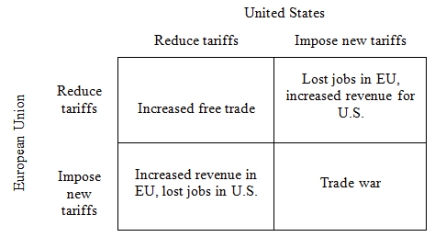Free Trade Game
Free trade occurs when goods and services between countries flow unhindered by government-imposed restrictions such as tariffs, quotas, and antidumping laws that are often designed to protect domestic industries. Although it is well known that free trade creates winners and losers, a broad consensus exists among most economists that free trade has a large and unambiguous net gain for society as a whole. For example, Robert Whaples (2006) finds in a survey of economists that "87.5% agree that the U.S. should eliminate remaining tariffs and other barriers to trade" and that "90.1% disagree with the suggestion that the U.S. should restrict employers from outsourcing work to foreign countries." Despite this consensus, it is not at all clear that countries will actually adopt policies promoting free trade.
Consider the following strategic situation in which the United States and the European Union (EU) are engaged in trade negotiations. Both countries must decide whether to reduce their tariffs or impose new tariffs. The best outcome for both countries is for them to impose new tariffs and for the other side to reduce tariffs; they could then export more easily to the other country and they would obtain increased revenue from the new tariffs. The worst outcome for both countries is for them to reduce tariffs and for the other country to increase tariffs; they would lose jobs as a result of reduced exports and the other country would benefit from their lower tariffs. Of the remaining two outcomes, both countries prefer the outcome in which they reduce tariffs to the one in which they both impose new tariffs. If both countries reduce their tariffs, then each country can benefit from increased free trade. If both countries impose new tariffs, there is a trade war in which each country sees a decline in trade and a loss of jobs. Based on this story, the preference ordering for the EU over the four possible outcomes is:
• Impose; Reduce > ; Reduce > Impose; Impose > Reduce; Impose.
And the preference ordering for the United States is:
• Reduce; Impose > Reduce; Reduce > Impose; Impose > Impose; Reduce,
where the EU's action is given first, the United States' action is given second, and ">" means "is strictly preferred to."
Using the ordinal preferences (4, 3, 2, 1) to capture these preference orderings, fill in the empty payoff matrix. Based on the preference orderings in the Free Trade Game.
Figure 1: Free Trade Game

-what is this sort of game more generally called?
Definitions:
Messenger RNA
A type of RNA that carries genetic information from DNA to the protein-making sites in cells, guiding the synthesis of proteins.
Water-soluble
Refers to substances that can dissolve in water.
Thyroid Hormone
Hormones produced by the thyroid gland, including thyroxine (T4) and triiodothyronine (T3), that regulate the body's metabolism.
Specific Tissues
Distinct types of material of which animals or plants are made, consisting of specialized cells and their products.
Q3: What is (are) the Nash equilibrium (equilibria)
Q4: An offer targeted to consumers and sold
Q9: A government is an entity that uses
Q14: Expanding into parallel products is referred to
Q15: A channel of distribution is a path
Q17: Which of the following factors might limit
Q25: What is the subgame perfect Nash equilibrium
Q25: Which of the following observations would falsify
Q37: If the<br>SMDP = single-member district plurality<br>If mixed
Q41: When we see a dictator removed from